
Telegram in which Percival Lowell informs Andrew Douglass of the name for his new observatory.
On April 3, 1894, an Easterner named Andrew Douglass checked into Flagstaff’s Bank Hotel. Douglass may have looked like an ordinary visitor, but his luggage was anything but ordinary. Included were two wooden boxes strongly resembling coffins. Inside the boxes were a six-inch diameter, seven-foot-long telescope weighing 30 pounds, and the telescope’s mount and wooden tripod weighing 75 pounds.
Since March 7, Douglass had been hauling this equipment around the Arizona Territory, seeking an ideal location for Bostonian Percival Lowell to establish an astronomical observatory for studying the planet Mars. After using the telescope to test atmospheric conditions at ten different stations in Tombstone, Tucson, Tempe and Prescott, Douglass was now in Flagstaff, appropriately nicknamed the Skylight City because of the brilliance of the evening’s stars.

From left: Lowell staff member Andrew Douglass, Godfrey Sykes, David Babbitt, and an unknown repair shop staff member.
As with the other towns Douglass visited, Flagstaff’s leaders were eager to have the observatory built in their community. Such an institution could supply jobs and, perhaps more importantly, bring prestige to an area trying to establish a cultural presence. The day after Douglass arrived, Douglass went to the home of lumberman D.M. Riordan, who extended an invitation for Douglass to lodge at his home. This was likely not only a gracious offer to a visiting dignitary, but also an opportunity for one of Flagstaff’s leading citizens to help sway the decision to build the observatory in Flagstaff. While at Riordan’s home, Douglass noted a four-foot pine log on which he counted 285 tree rings. Through the years, Douglass would continue to make similar observations, and he eventually established the science of dendrochronology at the University of Arizona.
On the evening of April 4, Douglass set the telescope up at his first Flagstaff observing station – Site 11 – on the hill just above the Arizona Lumber and Timber Company (the High Country Motor Lodge on West Rt. 66 now sits on this site).
By April 11, Douglass tested three other sites in the Flagstaff area: a hill near A1 Ranch (Arizona Cattle Company) six miles northwest of town, Elden “Mesa” and Wing Mountain.
Percival Lowell, anxious to get the observatory built, sent an historic telegram to Douglass on April 16, reading simply, “Flagstaff. Hurry preparations for dome.” A few days later, Douglass received a letter dated April 17 and signed by 82 Flagstaff citizens, pledging their support of the new observatory and declaring that the town would deed the necessary land and build a road to the city’s first permanent scientific institution.
On April 21, Lowell telegrammed Douglass his decision to build the observatory at Site 11. For the exact location of the telescope dome, Douglass chose a knoll ½ mile to the north, where the gentler slope allowed for easier construction of a road to the top of the mesa. Ground was broken on April 23, and construction was headed by local resident Ed Whipple.
The dome, largely constructed in Massachusetts, soon arrived and was assembled to house two large, borrowed telescopes. Percival Lowell arrived in Flagstaff on May 23, officially opening his observatory.
The dome and telescopes were later replaced by a 24-inch telescope housed in a large wooden structure. More than a century later, this dome still stands as an easily visible landmark from downtown Flagstaff.